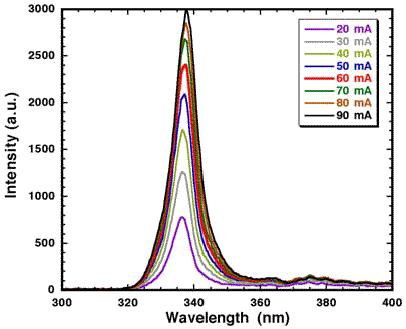
R e s e a r c h
O p t o e l e c t r o n i c s
U V L E D
One of the most promising methods of generating white light for applications such as display backlighting, accent lighting, and general illumination is the combination of a UV LED operating in the wavelength range of 340-400 nm and a combination of red and green emitting phosphors. This approach yields a more balanced white spectrum than the traditional blue emitter + yellow phosphor LED, and more simplified control than the combination of individual red, green, and blue LEDs to generate white light.
While LEDs operating at the long end of that wavelength range are commercially available, moving to operating wavelengths below the band-edge emission of GaN (365 nm) poses some interesting challenges. These structures incorporate AlGaN layers with the aluminum percentage increasing as the LED wavelength is shortened. For 340 nm emission, the active region consists of Al0.1Ga0.9N wells with the surrounding layers having higher Al percentages to provide carrier confinement. The two biggest challenges are: (1) strain and (2) doping. (1) AlGaN layers grown on GaN are in tension. As the structure is thickened, or the aluminum composition is increased, so does the strain - leading to higher dislocation densities and cracking for thick structures, or devices with shorter wavelength emission. (2) The bandgap of the material increases with increasing aluminum percentage (hence the shorter emission). As a result, most dopants have deeper levels within the bandgap and a greater dopant concentration is required to achieve a useful carrier concentration. The lowered carrier concentration results in higher internal and contact resistivities. Other difficulties include the lack of carrier localization (a feature of InGaN active regions in blue and green devices) to offset nonradiative recombination, and the strong polarization fields in AlGaN which lower the recombination efficiency.
Below 340 nm, UV emission becomes attractive for applications such as bioagent detection and short range communication. Of course, to achieve these wavelengths, even greater percentages of aluminum are required
Never-the-less, by employing various tactics such as the use of AlN base layers for stress reduction and short period alloy suprelattices (SPASL) for enhancement of carrier concentration we have fabricated devices operating below 340 nm. On-wafer testing yielded 39 µW at 100 mA DC, although proper packaging of the devices should enhance the power output. With continued improvement in material quality, these values should continue to climb.
 |
||||
| Spectrum for an AlGaN-based UV LED | ||||
Last updated
The Interdisciplinary Center for Wide Bandgap Semiconductors
The Solid State Lighting and Display Center
Copyright © 2001-2002